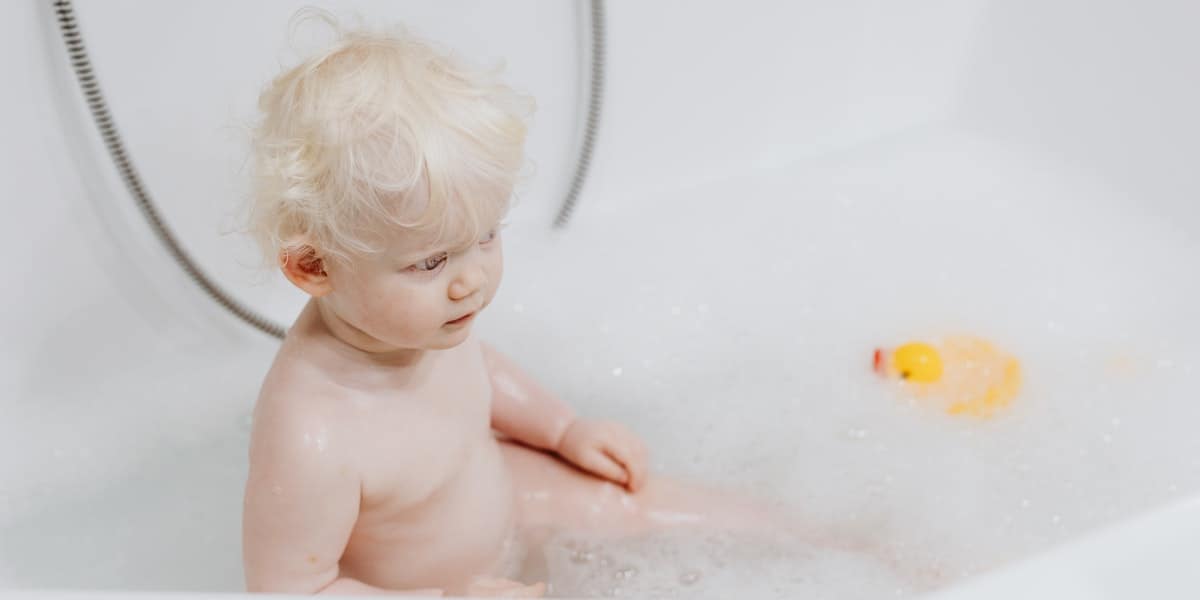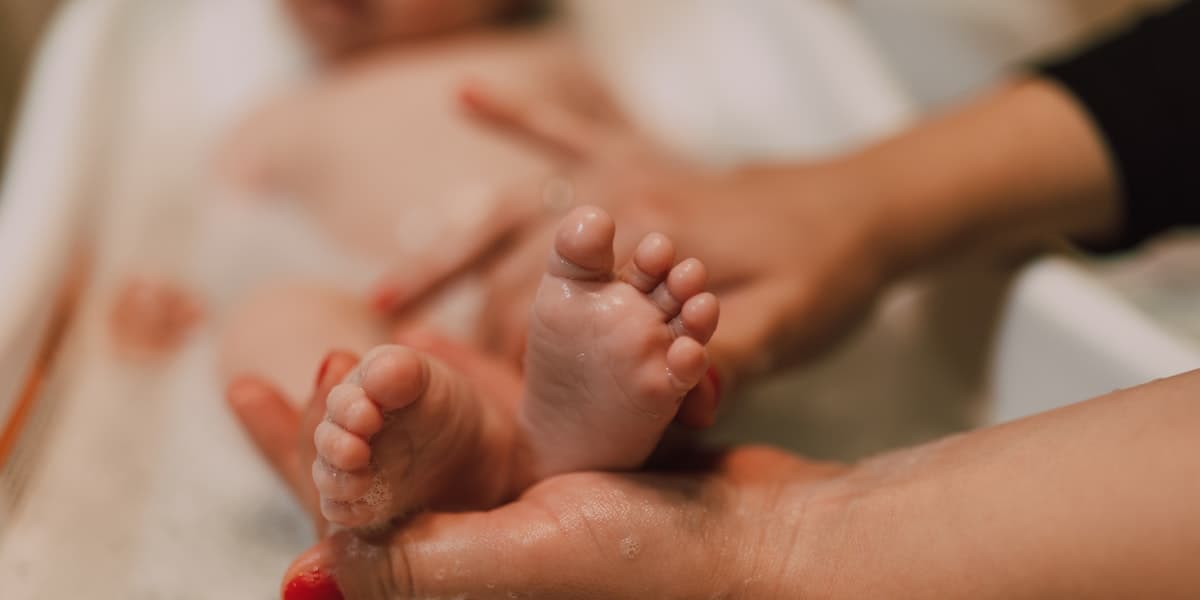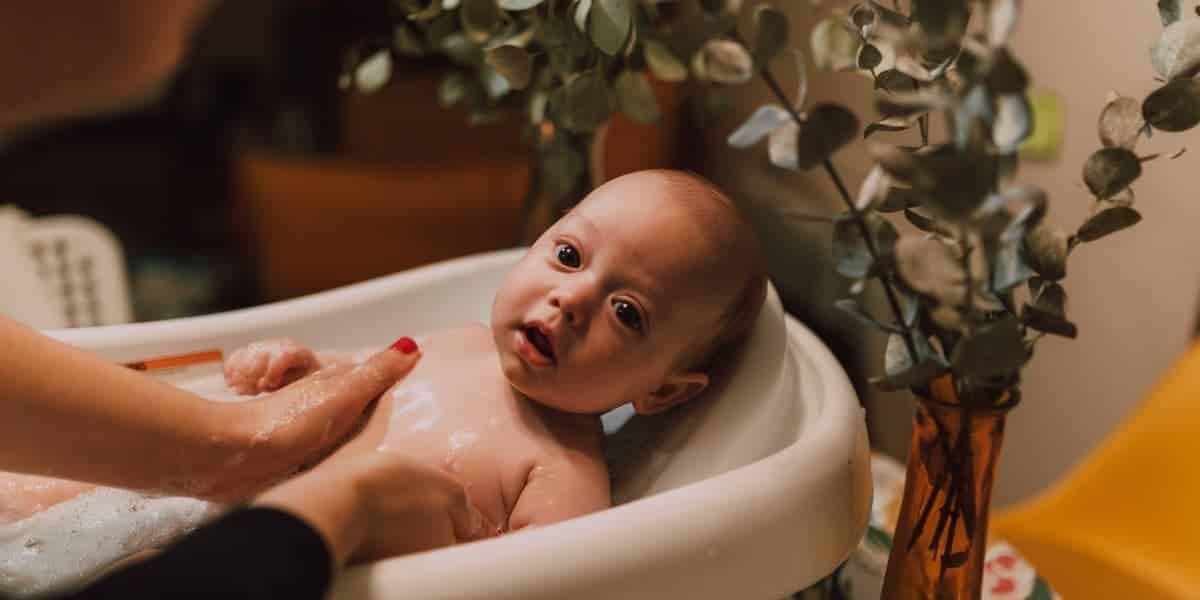When it comes to bathtime for your wee one you don’t want the water too cold or too hot. It should be just the right temperature (like Goldilocks wanted for her porridge).
Bathing your baby in water that is hot or cold can lead to them being burned or getting hypothermia. Test the temperature of the water by feel or use a thermometer. It needs to be at body temperature.
You want to keep the bath water warm for your baby. But how can you do it? Read on to discover a range of tricks to help you.
As an Amazon Associate, I earn from qualifying purchases. The links below may be affiliate links. Please read my disclosure policy for more information.
The water is too hot

We all know the dangers of hot water. It can burn and scald skin. The skin of your baby is very sensitive and will react quickly to hot water.
If the temperature of the water is 105°F or higher, then it’s too hot.
To make things easier for you, it’s possible to adjust the hot water temperature that comes out of your faucets. Lower it to between 100° F to 104°F then you are on the safe side for baby bath time.
The bath is so cold
At the other end of the spectrum is water that isn’t warm enough. If the water is cold (95° F or lower) you expose your baby to the possibility of getting hypothermia or cold stress.
Cold stress happens when the body of your baby isn’t producing enough warmth to make up for the heat she/he is losing.
Indications that your baby may be suffering from cold stress are:
- the muscles become weaker
- skin turns pale
- lethargy
- your child has trouble breathing or the breathing rate has increased
If you don’t deal with the issue, prolonged cold stress can lead to longer term health problems for your baby such as low blood sugar or heart problems.
It’s vital that you keep your bath water and the surrounding environment at a suitable temperature.
What is a good temperature for my baby?

The recommended safe temperature for baby bath water is between 98.6°F to 99.5° F. This is similar to the body temperature of your wee one.
When it comes to filling up the bath tub, there is debate as to whether you should use hot water first or cold water, or both at the same time.
Hot water first allows the bath to heat up, which means that it’s warmer. If you start with cold water, it will cause the hot water to cool down at a slower rate.
That makes the warmth of the water last longer. However, this option may have you needing to add in more hot water in order to get the bath to the right temperature.
Filling up the bath with both hot and cold water at the same time allows the water to mix. That way you don’t get hot and cold spots within the water.
Choose which way suits you best.
How do you know that the water is at the right temperature?
Before you place your wee bundle of joy into the bath water, you need to check that it’s at the ideal temperature.
You can use a thermometer. Just submerge it slightly under the surface of the water for a minute or so then check the reading.
There are some adorable ones available on Amazon. B&H have a range of cute thermometers to choose from.
Another method is to place your hand or arm into the water. It should feel warm to the touch. However, this method can be hit and miss as you don’t know the exact bath temperature.
How do I keep the water warm?
Once you have the bath at the ideal temperature, you will want to keep it from cooling down. The trick is to trap the heat either in the room or within the water.
The following methods help to keep the water and environment cosy and warm.
1. Use a heater
If the bathroom (or whatever other room you use to bath your baby in) is prone to drafts and cold, use a heater to keep the area warm.
Place the heater near the most obvious source of cold air. The smaller the room, the faster it will warm up and reach the ideal temperature.
A thermostatically-controlled heater is a good option because you can set the ambient temperature, then the heater does its thing to keep the room at that setting.
You don’t need to go all out and install a permanent heater, a portable one will do the trick.
2. Keep the door closed
Open doors is one way to have the hot air leave one room and enter another. If you are wanting to prevent your baby’s bath water from cooling down, close the door. Preheat the room if you can, this will keep the environment warm.
Place draft stoppers along the bottom of the door to stop nasty cold air from seeping into the room (and warm air escaping). If there are windows in the room, close the blinds or curtains (or use towels if you don’t have such fixtures).
Find other potential gaps around the room where the warm air can escape from. Plug these up.
3. Warm up the bath

On those cold winter mornings you might have the habit of warming up your coffee cup (or tea cup) with hot water. Then you tip out the water and make your drink.
Your first initial action was to allow the cup to warm up. This helps the second lot of water stay hot as you have your cuppa.
The same principle can be applied to your baby’s bath tub. Fill it with slightly hotter water and allow the tub to heat up.
Empty out the water and then replace it with the final bath water. The heated surrounds of the tub should help keep the water nice and warm.
4. Make a bath cover
In Japan, where a family can share the bath water among its members, the temperature of the water is retained by placing a cover over the bath.
Use this same concept to have your baby’s bath water kept warm. You can make your own cover:
- Create a template of the top of the tub
- Trace around the template onto a piece of wood or sheet of plastic
- Cut out the shape
- Pop your new cover over the top of the tub
Another option is to use a towel or something similar to drape over the tub.
Keeping your baby warm
During bath time you not only want to keep the water warm, but your baby also.
To stop your wee one from getting cold, wrap the non-submerged parts of their body with a warm cloth.
Have all your baby washing gear ready to go before bathtime. A great idea is to have a special bath kit in which you have everything you need. That way you don’t need to spend time looking around the house for the baby sponge or soap.
Keep the bath time short. That doesn’t mean rushing through the process. Usually 5-10 minutes is sufficient. Any longer and there is the chance that the water (and your baby) start to get cold.
Once bath time is over, wrap your wee one into a warm towel and pat him/her dry. Then slip your baby into a set of warm clothes.
What can you do if your baby doesn’t like having a bath?

Some babies may put up a fuss when it comes to bath time. Because they can’t tell you what’s upsetting them, you are left wondering what the problem is. Maybe the baby doesn’t like the tub, or they are hungry, or perhaps they are cold.
Here are some ways to solve the issue when your baby doesn’t love bath time:
- Gradually add the water: Some babies don’t like being suddenly placed into a tub of water (even if it’s 2 inches deep). You can get your wee one used to bath time by gently pouring water over them
- Bath after feeding or nap time: Your baby may be upset because she/he is hungry or perhaps tired. Try doing bath time after you have fed your baby or when she/he has woken up from a nap
- Try a bath pillow: It could be that the tub you are using is a little uncomfortable for your baby. That may be what all the fussing is about. You can see if using a bath pillow will help
- Sing and talk to your baby: The soft, soothing melody of a parent’s voice can help ease any tension your child may be experiencing. During bath time, sing gently to your baby and have a chat with them.
- Have a routine time: Children develop a sense of safety and comfort when things happen at a regular time. When routines aren’t kept, you may experience tears from your baby. When it comes to bath time make it the same time.
Conclusion
When it comes to bathing your baby, you don’t want the water so hot that it will burn. Nor do you want it too cold that your baby will start to experience cold stress. The ideal temperature for baby bath water is around 99°F.
You can test the temperature either by feel or use a thermometer.
To keep the water warm, heat up the room or have the door closed. To prevent your baby from losing body heat, use a warm cloth to wrap around any part of the body you aren’t washing.
If your baby isn’t a fan of bath time, you will need to use some trial and error to determine why.
Make the experience an enjoyable time for both you and your child. Let them know that bath time is fun time!


